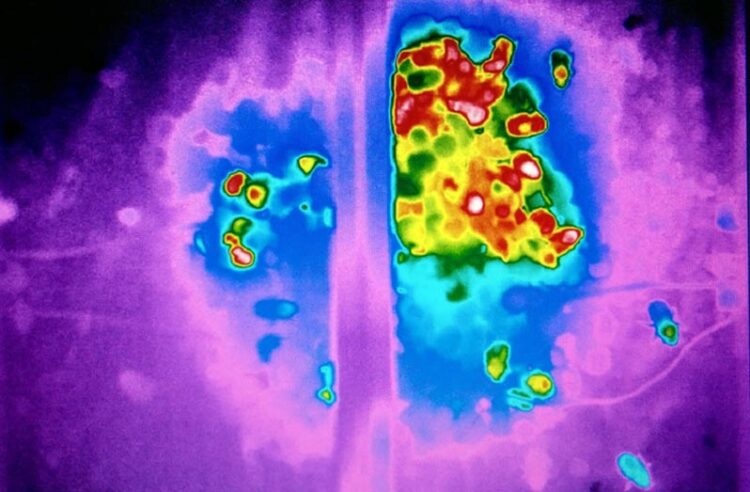How glyphosate affects brood care in bumblebees

Thermal image of the divided bumblebee colony: left with glyphosate, right untreated.
Credit: Anja Weidenmüller
The decline of insects, and in particular pollinating insects, threatens ecosystems and economies around the world. The dimensions are staggering: Between 1989 and 2016, the biomass of all flying insects in Germany decreased by 76 per cent, according to the Krefeld study (2017). The ever-increasing use of pesticides in agriculture is considered a driver of this phenomenon. The world’s most widely used herbicide glyphosate may contribute more to this development than was previously known, according to a new study by researcher Dr Anja Weidenmüller from the Cluster of Excellence “Centre for the Advanced Study of Collective Behaviour” at the University of Konstanz (published on 3 June 2022).
The biologist is studying the ability of bumblebee colonies to regulate the temperature of their brood. Bumblebee colonies that have sufficient nectar available as ‘fuel’ keep their broods at a constant temperature of about 32 degrees. “Just as we humans keep our body temperature constant, the animals in a colony collectively show homeostasis in the temperature regulation of their brood,” says Weidenmüller. This joint thermoregulation is of outstanding importance for colony development. Only at such high temperatures does the brood develop quickly from egg to bumblebee and the colony from a single queen to a colony of several hundred individuals. The current study shows a clear impact of glyphosate on the collective thermoregulatory capacity of bumblebee colonies.
Time pressure for bumblebee colonies when resources are scarce
“When resources become scarce, you see very clearly that the collective thermal behaviour of colonies that have been chronically exposed to glyphosate is affected,” says Weidenmüller. “They cannot keep their brood warm for as long.” This effect is the main result of her study, which she conducted together with four researchers from the University of Konstanz, the Max Planck Institute of Animal Behavior in Konstanz and the University of Otago, Dunedin, New Zealand. “Bumblebee colonies are under really high pressure to grow as quickly as possible within a short period of time,” says Weidenmüller. If they cannot maintain the necessary brood temperature, their brood will develop more slowly or not at all. This limits the growth of the colony. “Only when they reach a certain colony size during the relatively short growth period are they able to produce the sexually reproductive individuals of a colony, i.e. queens and drones.”
Reproduction endangered
In times of resource scarcity, however, bumblebee colonies contaminated by glyphosate are less able to keep their brood warm, if at all. Due to the predominant agricultural landscape in Germany, fewer wild flowers are available to insects, resulting in increased resource scarcity. “The combination of resource scarcity in cleared agricultural landscapes and pesticides can therefore pose a massive problem for colony reproduction,” says Weidenmüller.
Rethinking the approval procedure for pesticides
“It’s worth taking a closer look,” Weidenmüller emphasises. So far, approval procedures only test how many animals have died after being fed or coming into contact with a substance after 24 or 48 hours. “Sublethal effects, i.e. effects on organisms that are not lethal but can be seen, for example, in the animals’ physiology or behaviour, can have a significant negative impact and should be taken into account when pesticides are approved in future,” she says. In her study, the bumblebees exposed to glyphosate also lived an average of 32 days, thus reaching an average bumblebee age.
Glyphosate is currently approved for use in the EU until 15 December 2022, according to information from the European Food Safety Authority (EFSA). The Glyphosate Renewal Group (GRG) applied for renewal in 2019.
In principle, Weidenmüller’s research approach can be applied to all pesticides. For many of the commonly used pesticides, such as other herbicides and fungicides, we still know next to nothing about their effects on wild bees and other pollinators, she says. In our discussion of future agricultural approaches, test procedures used for assessing the risks involved with our heavy use of chemicals should be reconsidered.
Key facts
|
Note to editors:
Photos can be downloaded here:
Thermal image: https://cms.uni-konstanz.de/fileadmin/pi/fileserver/2022_EXSTRA/Glyphosat_Brutpflege_Hummeln_Waermebild_I.jpeg
Caption: Thermal image of the divided bumblebee colony: left with glyphosate, right untreated.
Photo: Anja Weidenmüller
Bumblebee colony: https://cms.uni-konstanz.de/fileadmin/pi/fileserver/2022_EXSTRA/Glyphosat_Brutpflege_Hummeln_Splitcolony.jpeg
Caption: Divided bumblebee colony: left with glyphosate, right untreated.
Photo: Anja Weidenmüller
Research team: https://cms.uni-konstanz.de/fileadmin/pi/fileserver/2022_EXSTRA/Glyphosat_Brutpflege_Hummeln_Autorenbild.JPG
Caption: The study was funded by the Cluster of Excellence “Centre of the Advanced Study of Collective Behaviour”. Involved in the study were (from left to right) Anja Weidenmüller, Andrea Meltzer, Alica Schwarz, Professor Christoph Kleineidam and Dr Stefanie Neupert (not in the photo).
Photo: Elisabeth Böker
Journal: Science
Method of Research: Experimental study
Subject of Research: Animals
Article Title: Glyphosate impairs collective thermoregulation in bumblebees
Article Publication Date: 3-Jun-2022
Media Contact
Helena Dietz
University of Konstanz
kum@uni-konstanz.de
Office: +49 (0)7531-88-3603
All latest news from the category: Ecology, The Environment and Conservation
This complex theme deals primarily with interactions between organisms and the environmental factors that impact them, but to a greater extent between individual inanimate environmental factors.
innovations-report offers informative reports and articles on topics such as climate protection, landscape conservation, ecological systems, wildlife and nature parks and ecosystem efficiency and balance.
Newest articles

Combatting disruptive ‘noise’ in quantum communication
In a significant milestone for quantum communication technology, an experiment has demonstrated how networks can be leveraged to combat disruptive ‘noise’ in quantum communications. The international effort led by researchers…

Stretchable quantum dot display
Intrinsically stretchable quantum dot-based light-emitting diodes achieved record-breaking performance. A team of South Korean scientists led by Professor KIM Dae-Hyeong of the Center for Nanoparticle Research within the Institute for…

Internet can achieve quantum speed with light saved as sound
Researchers at the University of Copenhagen’s Niels Bohr Institute have developed a new way to create quantum memory: A small drum can store data sent with light in its sonic…





















